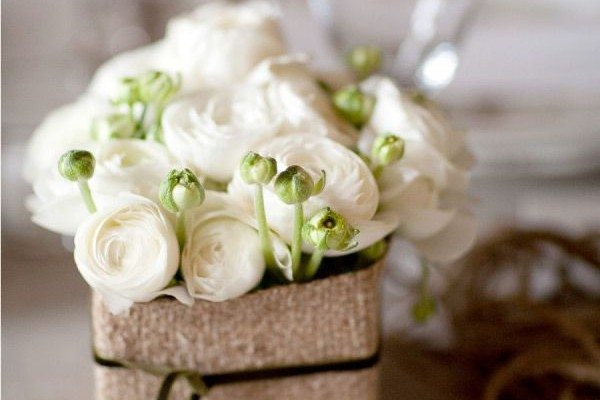The Wedding Song
There they stand, hand in hand, and exchange wedding bands.
Today is the day of all their dreams and plans.
And all of their loved ones are here to say,
God bless this couple who marry today.
In good times and bad times, in sickness and health,
May they know that riches aren’t needed for wealth.
Help them face problems they’ll meet on their way —
God bless this couple who marry today.
May they find peace of mind comes to all who are kind,
May the rough times ahead become triumphs in time,
May their children be happy each day —
God bless this family who started today.
As they go, may they know every love that was shown,
And as life it gets shorter may their feelings grow.
Wherever they travel, wherever they stay,
God bless this couple who marry today.
Celtic Traditions
The ancient and symbolic ceremony of hand-fasting was often performed by our Celtic kinsmen. To include this beautiful tradition into a wedding, you’ll need either a rope or a length of fabric to wrap around the couple’s hands. The type of “wrap” could include anything that has meaning to the both of you. It could also complement the colors or theme you chose for your wedding.
Some couples have used the remnants of their personal baby blankets or a cherished scarf their grandmother wore. In some families the wrap or rope is passed down through the generations.
Whatever your choice of “wrap,” the tradition signifies that the bride and groom are united as one. This symbolic tradition is often referred to as tying the knot. In your ceremony, the two of you will face each other, join right hands to right hands and left to left, and a friend or officiant will wrap the chosen fabric or rope around your interlocked hands.
Another widely utilized and meaningful tradition is the bagpiper. The piper shows up in a variety of ways at Celtic weddings. The piper can perform as musical accompaniment, standing next to the groom, as the bride walks down the aisle. Other couples have chosen the piper to lead both the bride and groom into the wedding. Locations can be churches, outdoor gardens or other places and will be discussed later in the “decision” section of this article. Whatever your choice of the piper’s role, a bagpiper will make the ceremony rich in Celtic heritage and custom.
While the traditions of hand fasting and bagpipers are the most popular rituals for a Celtic wedding, there are several others to think about.
- The bride carrying a horseshoe is a custom dating back as far as 3-400 years. But carrying an actual horseshoe is a bit cumbersome and heavy. Many brides today choose to have the emblem of one sewn inside her dress or embroidered onto the hand-fasting wrap. The symbolism of the “shoe” is what is important. It’s meant to bring good luck to the couple.
- The “Grushie” custom is performed by the groom. He tosses a handful of coins into the crowd at the wedding reception or line of recession as he and his new bride leave the church or have been pronounced as lawfully married. It’s best to make sure the coins are small, or ones that have been especially made for this purpose. Heavy coins could injure someone.
- The custom of a barefooted bride and groom symbolizes a grounding or connection to the earth. This very old custom was performed for those Celtic peoples that wanted to honor mother earth. I still think that this tradition was designed to honor, but also for comfort as well. Unless of course you’re getting married on a ground laden with sharp stones or rock.
The above mentioned Celtic traditions are by no means the only ones. But whether you choose to use one or all, they’re certain to give your ceremony an atmosphere of love and honor for our Celtic heritage.
Decisions Involved in Your Celtic Wedding
Every wedding is full of having to make decisions. Deciding which tradition(s) you want is just a start. The next step is to decide on a location. No matter what traditions you choose to follow, you’ll need a place to perform the marriage ceremony. After choosing a location, the bride and groom should decide who’s going to make the rest of the decisions.
Making wedding arrangements can often run into an endless problem of “He says, She says.” Knowing who’s going to be responsible for each planning task can defuse a lot of stress and arguments. The following are some suggestions on who should do what. Of course, depending on the couple, you can rearrange these to suit whoever’s better at performing certain tasks.
Both the Bride and Groom should:
- Decide on the location of the wedding.
- Decide who is going to perform the ceremony. Not all licensed clergy are aware of the traditional Celtic wedding vows or exchanges of commitment.
- Choose rings that symbolize your love for each other, as well as ones that reflect that reflect your Celtic heritage. This task doesn’t have to be agonizing. I found the website http://www.celtic-weddingrings.com was a great place to start researching a Celtic knotwork design suitable for my fiancée and I.
- Choose the remaining male attendants (groomsmen, ushers) together.
- Choose the male wedding attire. Both of you should do this, so that the groom can wear a color he likes, yet you can choose one that suits your wedding’s “theme” colors as well as the bride’s dress and flowers. It’s best that you both do this, because the groom doesn’t know (well, he shouldn’t, anyway) what color(s) are in the wedding gown or its trim and embroidered work.
Just the Bride:
- Decide on the wedding gown. You may need to consult with a dress designer or company that specializes in Celtic wedding attire. If wish to have a dress that reflects your Celtic heritage, many options are available to you. Many Celtic brides choose, somewhere on the dress, to have the Celtic knot sewn or patterned into the gown. The “knot” symbolizes love, commitment and life. This would complement the hand-fasting ceremony nicely, too.
- Choose the maid or matron of honor and other attendants.
- Plan the flower arrangements, wedding favors (name cards, catering, stationary to name just a few). When you choose your attendants be sure to have them help you with these too.
Just the Groom:
- Plan the honeymoon. How about a trip to a Celtic land? What better place to go than where your Celtic roots began?
- Choose a best man. A best man is a male friend or family member you feel cares the most about you. This is an important choice because you will need some help with the time consuming tasks that always come with planning a wedding and honeymoon.
Planning your Celtic wedding will be one of the most important events you will ever oversee. Someday, whether 30 or 60 years later, the both of you will remember your wedding day as a blessing. It’s the day the two of you announced your commitment to each other. And it’s the day your Celtic ancestors looked upon you in spirit and smiled.


